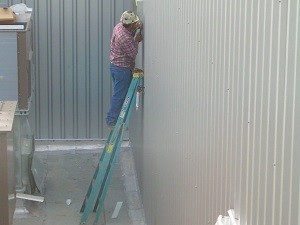How to Safely Use a Ladder should be Workplace Safety 101 ... so why isn't it? No matter how high off the ground, a tumble off a ladder can have serious consequences.

According to OSHA, falls from portable ladders are one of the leading causes of occupational fatalities and injuries. NIOSH reports that more than 500,000 people in the US are treated for ladder injuries every year and about 300 people die EVERY YEAR from ladder-related injuries.
OSHA Standard 1910.23(b)(9) states that the employer must ensure that ladders are inspected before initial use in each work shift, and more frequently as necessary, to identify any visible defects that could cause employee injury.
Always visually inspect all step ladders before use for any defects such as: missing/broken rungs, bolts, cleats, screws and loose components.
- Remove defective ladders from service immediately.
- Never attempt to repair a ladder! Do not use wire, screws, bolts, duct tape or electrical tape as a way to fix the ladder; instead tag it and remove it from service.
- To learn more about ladder inspections and to download your free ladder inspection checklist, check out this article: Ladder Inspections.
OSHA Standard 1910.23(b)(11) states that the employer must ensure that each employee faces the ladder when climbing up or down it.
- Never stand on the top rung or step of the step ladder. This makes the ladder very unstable and prone to tip over!
- Never face away from the step ladder! This can easily cause you to fall!
- Never over-reach on a step ladder!
- Do not move or shift a ladder while a person or equipment is on the ladder. This could cause the materials or person to fall and cause serious injury.

If ladders are used by employees occasionally, regularly or daily (hint: if they are used AT ALL) then an annual safety meeting on ladder safety is a must! Here are some more important points to emphasize during the safety meeting or toolbox talk on ladder safety.
- Use the right ladder for the job! Employees should use the correct ladder rated for their body weight and their tools.
- Always read the ladders warning labels and follow the manufacturer’s recommendations for use.
- Only use a ladder that is rated to support the weight of your body and your tools/equipment.
- Make certain that the ladder is not loaded beyond the maximum intended load.
- Never use one side of a disassembled step ladder as an extension ladder.
OSHA Standard 1910.23(b)(1) states that the employer must ensure that ladder rungs, steps, and cleats are parallel, level, and uniformly spaced when the ladder is in position for use.
Don't forget to download your FREE LADDER INSPECTION FORM from Weeklysafety.com. It's an important part of your safety program and there's no need to waste time creating one yourself. No credit card or email required! Just click the image below.

.jpeg)

.jpeg)